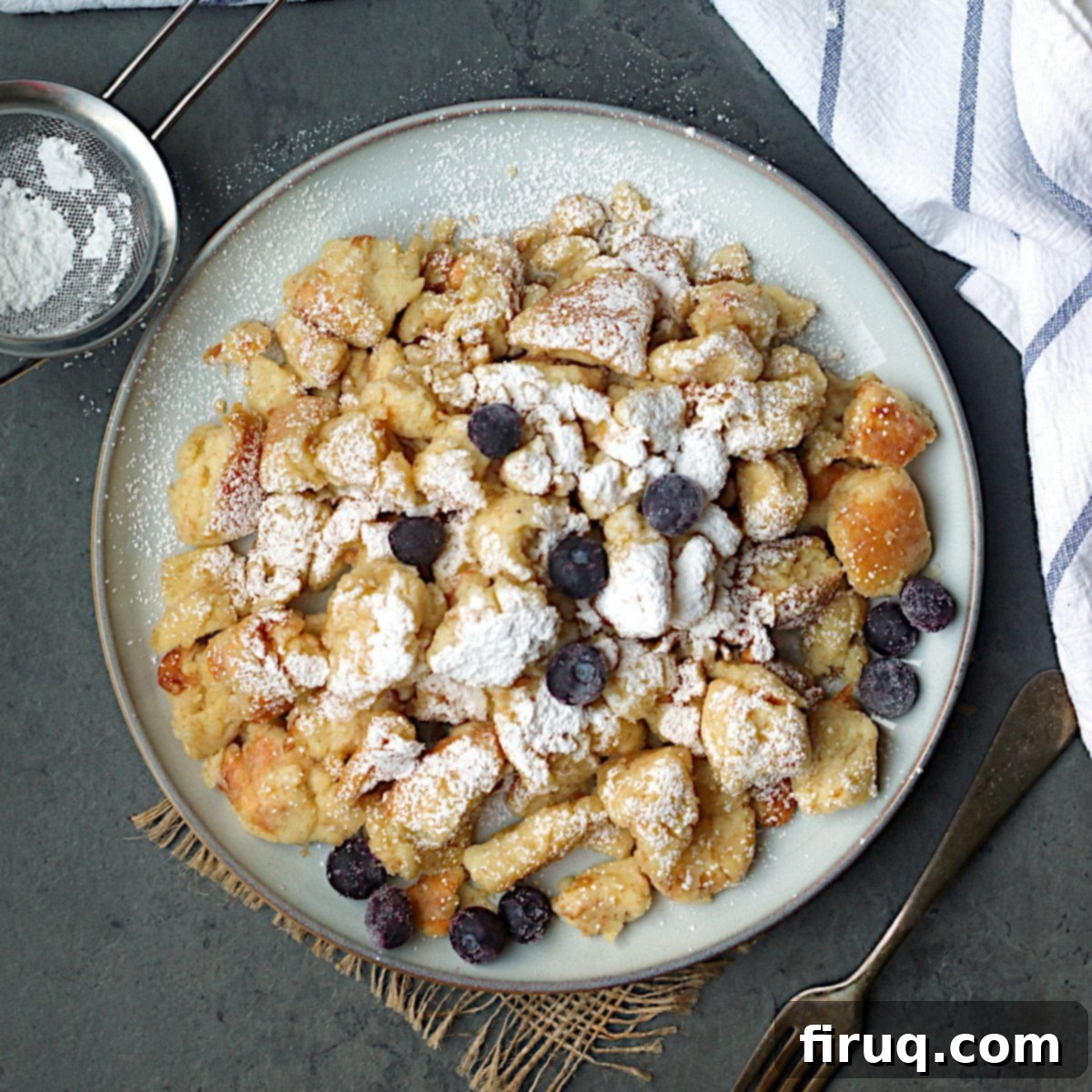Authentic Kaiserschmarrn Recipe: How to Make Fluffy Austrian Shredded Pancake
Welcome to the delightful world of Austrian cuisine, where simple ingredients transform into truly memorable dishes. Today, we’re diving into a beloved classic that stands out from typical pancakes: the Austrian Shredded Pancake, famously known as Kaiserschmarrn. This isn’t just any pancake; it’s a culinary experience – a fluffy, oven-baked creation, torn into bite-sized pieces, and then sautéed in butter until perfectly caramelized. The result is a uniquely light yet satisfying dish that is both delicious and incredibly fun to eat.
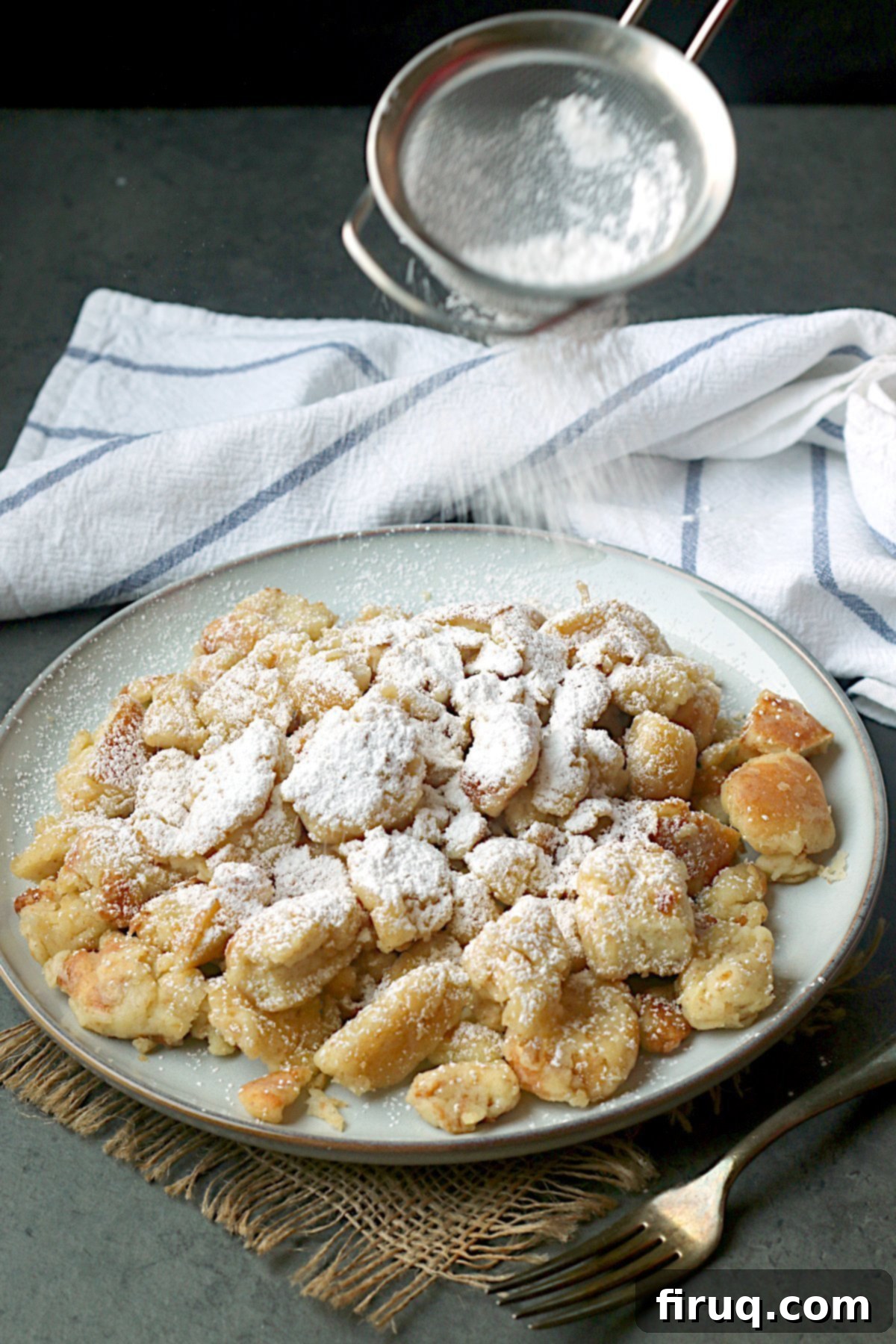
My collection of pancake recipes has grown quite extensive over time, and honestly, who can resist a good pancake? They are a universal comfort food, cherished across cultures in countless forms. However, the Kaiserschmarrn recipe we’re exploring today offers a distinct twist that sets it apart. Unlike traditional pancakes that are served whole, Kaiserschmarrn comes to your plate already deconstructed into charming, irregular pieces, making it the ultimate easy-to-enjoy breakfast or dessert. Today, I’m thrilled to share with you the recipe for Austrian Shredded Pancake, better known by its original name, Kaiserschmarrn.
When I first ventured into making this dish, I harbored a slight apprehension that it might turn out overly “eggy” due to the significant number of eggs in the recipe – roughly double that of a typical American pancake. Indeed, the finished, fluffy pancake bites often visually resemble scrambled eggs, leading to its playful nickname: “Austrian Scrambled Pancakes.” However, I can confidently reassure you that any concerns about an eggy taste are completely unfounded. Even my own children, who are notoriously picky about eggs, enthusiastically devour a plate of this authentic Austrian delight. The magic truly lies in the preparation method, particularly the incorporation of whipped egg whites, which gives Kaiserschmarrn its signature light and airy texture.
What is Kaiserschmarrn? Understanding this Austrian Delight
Kaiserschmarrn is a classic Austrian dish, primarily enjoyed as a hearty breakfast, a satisfying brunch, or an indulgent dessert. Its name, literally meaning “Emperor’s Mess” or “Emperor’s Scramble,” is steeped in legend, often associated with Emperor Franz Joseph I. Lore suggests that it was either a dish prepared for him that didn’t quite turn out perfectly (hence the “mess” or “schmarrn”) but was loved nonetheless, or a favorite dish of his that he enjoyed in a simpler, shredded form. Regardless of its exact origin, Kaiserschmarrn has become a staple in Austrian and Bavarian alpine cuisine.
This unique pancake is crafted from a rich batter primarily made from wheat flour, typically leavened with baking powder and, crucially, lightened by the generous addition of whipped egg whites. This technique is key to achieving its characteristic airy, fluffy texture. Once baked until golden, the pancake is not served whole but is famously torn or “shredded” into irregular, bite-sized pieces. These pieces are then traditionally sautéed in butter until they develop a beautiful golden-brown caramelization, enhancing their flavor and adding a slight crispness to the edges.
Authentic Austrian Shredded Pancake can feature delightful additions like raisins (often soaked in rum for extra flavor) or other dried fruits mixed into the batter. It’s almost always served warm, generously dusted with powdered sugar, and often accompanied by traditional fruit preserves, apple compote (Apfelmus), or plum compote (Zwetschkenröster). Some modern variations might include fresh fruit, but the classic presentation with powdered sugar and compote is truly iconic. This versatile dish is a testament to the comforting and rich flavors of traditional Austrian cooking, offering a delightful experience with every shredded, buttery bite.
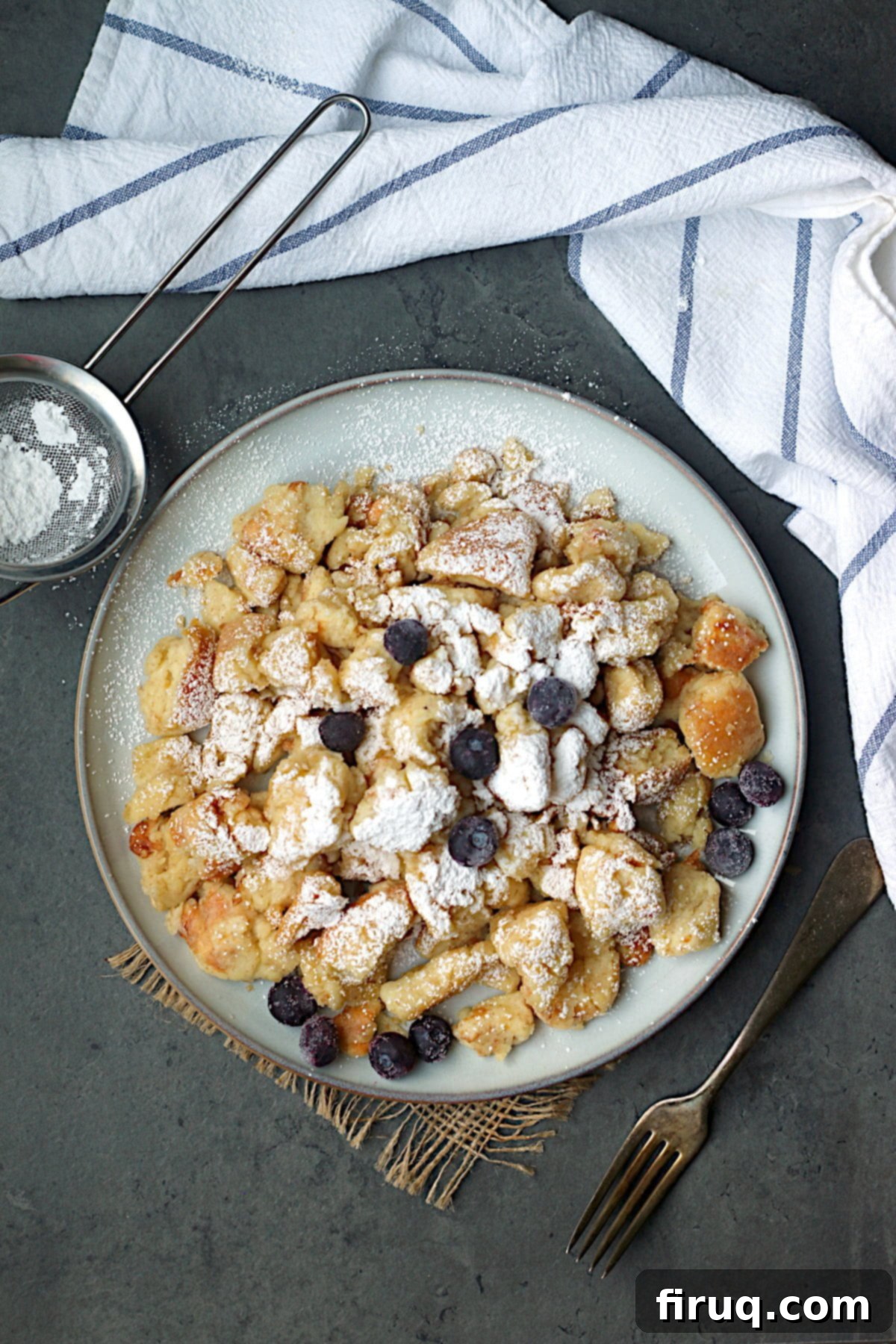
How to Make Authentic Austrian Shredded Pancake (Kaiserschmarrn)
Crafting these delectable pancake bites is a rewarding process that combines simple baking with a final sautéing step to achieve their signature texture and flavor. The secret to their incredible lightness and fluffiness lies in the careful preparation of the batter, specifically the generous addition of four whipped egg whites. These egg whites are folded into the batter, creating an airy base that puffs beautifully in the oven.
Preparing the Batter: The Key to Fluffiness
The batter for Kaiserschmarrn is unique because it separates the egg yolks and whites. First, the egg yolks are combined with milk and a portion of the sugar, forming the liquid base. Then, flour, baking powder, and a pinch of salt are gently folded in, creating a smooth mixture. The real magic happens when the egg whites are beaten separately until they form soft, airy peaks with the remaining sugar. This meringue-like consistency is then delicately folded into the yolk batter. This step is crucial; it incorporates air, which expands during baking, giving the Kaiserschmarrn its signature light and airy interior. Be careful not to overmix, as this can deflate the egg whites and result in a denser pancake.
Baking to Perfection: The Oven-Cooked Phase
Once your batter is ready, it’s baked in a pre-heated, oven-proof skillet that has been generously buttered. I personally love using a cast iron skillet for its excellent heat retention and even cooking, which helps achieve a lovely golden crust. However, a good quality non-stick oven-safe skillet will also work wonderfully. The skillet should be hot before the batter goes in, as this helps create an immediate sizzle and aids in the puffing process.
You’ll bake the pancake until its edges are beautifully set and golden, but here’s a crucial tip: the center should still be somewhat uncooked and wobbly. This partial cooking allows for easy shredding later and prevents the pancake from becoming dry. Refer to step 5 in the detailed recipe below for a visual guide on what to look for at this stage.
The Art of Shredding: Turning Pancake into Kaiserschmarrn
Once the pancake reaches this stage, carefully remove the hot skillet from the oven. Now comes the defining moment of Kaiserschmarrn: the shredding. Using a non-metal utensil like a sturdy spatula or flipper is essential, especially if you’re working with a non-stick pan, to avoid scratches. The pancake is surprisingly easy to cut; you can even use the edge of your spatula to tear it into irregular, bite-sized pieces directly in the pan. I prefer to do this right in the skillet to minimize mess and to keep the heat within the pan, which is vital for the next step. Aim for pieces roughly 1 to 1.5 inches in size – there’s no need for perfect uniformity; the “schmarrn” (mess) is part of its charm!
Sautéing and Caramelization: The Final Touch
With your pancake shredded, it’s time to complete the cooking process on the stovetop. Add a little more butter to the pan – I find that cutting it into small pieces and distributing them around the skillet ensures even melting and coating. Over medium heat, begin to sauté the shredded pancake pieces, stirring frequently. This step is where the magic truly unfolds. The butter helps the pieces caramelize, developing a rich, golden-brown hue and a delightful, slightly crispy exterior while keeping the inside wonderfully soft. Continue sautéing until all the Kaiserschmarrn bites are fully cooked through, beautifully browned, and thoroughly warmed. This final sauté not only cooks the previously undercooked center but also infuses the pieces with a delicious buttery flavor and irresistible texture.
Serving Suggestions: Enjoying Your Kaiserschmarrn
Traditionally, Austrian Shredded Pancake is served warm with classic accompaniments such as homemade fruit preserves, plum compote (Zwetschkenröster), or apple compote (Apfelmus). However, feel free to personalize your serving! I particularly enjoy mine with a generous dusting of powdered sugar and a drizzle of rich maple syrup. For an added burst of color and fresh flavor, consider incorporating some fresh berries like blueberries or raspberries, or thawed frozen fruit. The contrast of the warm, buttery pancake with cool, tart fruit is simply divine. Whether you opt for a traditional approach or a modern twist, Kaiserschmarrn promises a satisfying and truly unique breakfast or dessert experience.
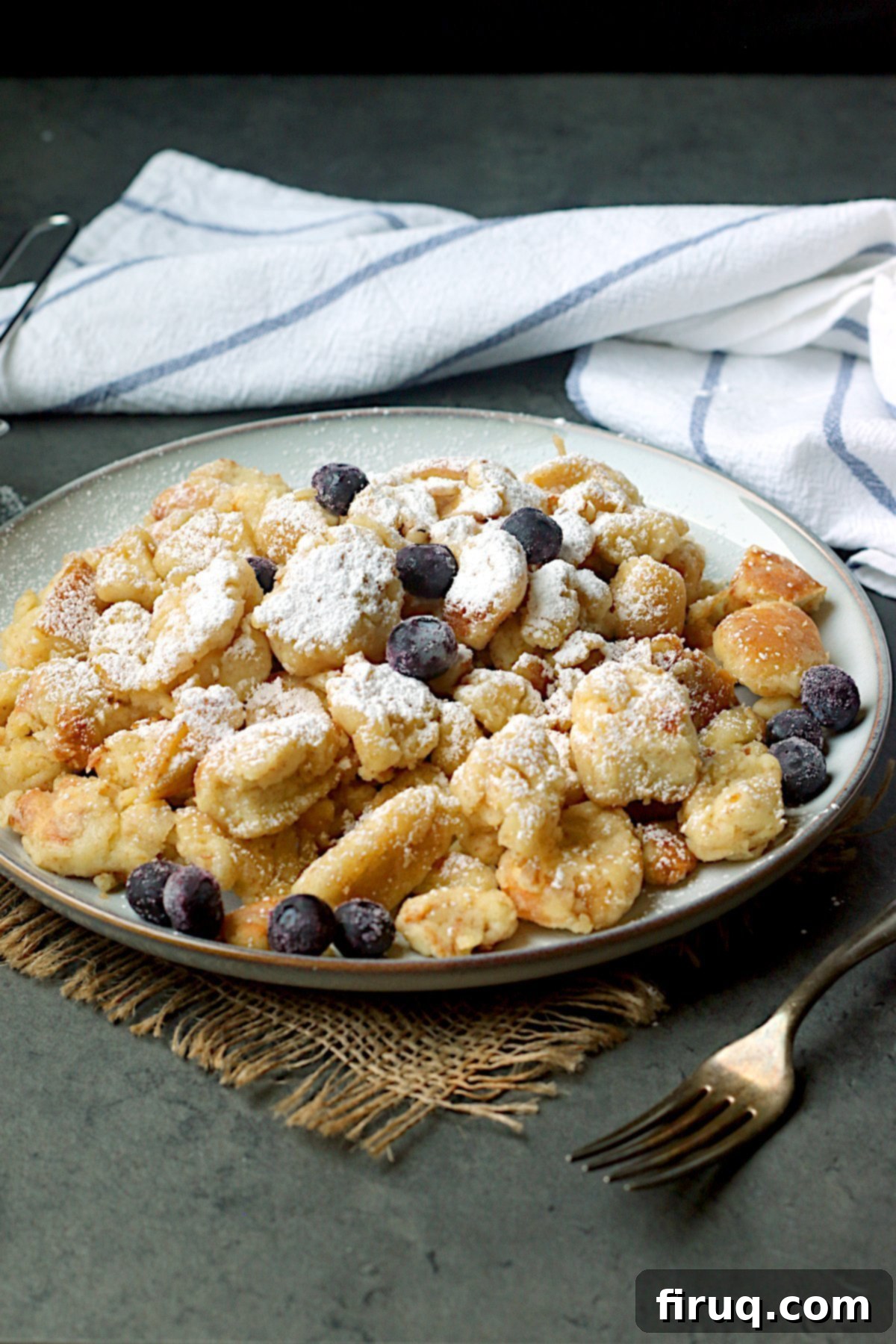
Essential Austrian Shredded Pancake Ingredients:
The beauty of Kaiserschmarrn lies in its relatively simple, wholesome ingredients that come together to create something truly special. Here’s a closer look at what you’ll need and why each component is vital:
- Large Eggs: The star of the show, separated into yolks and whites. The yolks provide richness and color, while the whipped whites are crucial for that signature fluffy, airy texture.
- Milk: Adds moisture and contributes to a tender crumb. For a dairy-free version, simply use your favorite plant-based milk alternative, such as almond, soy, or oat milk.
- Granulated Sugar: Sweetens the pancake and helps achieve a beautiful golden-brown caramelization during the sautéing process.
- All-Purpose Flour: Forms the structural base of the pancake, providing substance.
- Whole Wheat Flour (Optional): A small amount can add a subtle nutty flavor and a boost of fiber. If you prefer a lighter texture or don’t have whole wheat flour on hand, you can easily substitute it with an additional 1/4 cup of all-purpose flour.
- Baking Powder: A leavening agent that works alongside the whipped egg whites to give the pancake an extra lift and lightness.
- Salt: A pinch of salt is essential to balance the sweetness and enhance all the other flavors in the dish.
- Unsalted Butter: Used generously for both baking the pancake and sautéing the shredded pieces. Butter is key to developing that rich, caramelized flavor and crispy edges. To make this recipe dairy-free, use a high-quality dairy-free butter alternative.
- Powdered Sugar, Syrup, Fruit, or Jam to Serve (Optional): These are the traditional and popular accompaniments. Powdered sugar adds a delicate sweetness and a beautiful finish, while fruit preserves or compotes provide a refreshing contrast. Maple syrup is a delicious alternative for those who love classic pancake toppings.
Want More Delicious Pancake Recipes? Explore Our Collection!
If you’ve enjoyed the unique experience of Kaiserschmarrn and are eager to explore more delightful pancake variations, you’re in luck! Our kitchen is always whipping up new and exciting pancake creations. From fruity twists to international favorites, there’s a pancake recipe for every craving and occasion. Discover some of our other top picks that are sure to become family favorites:
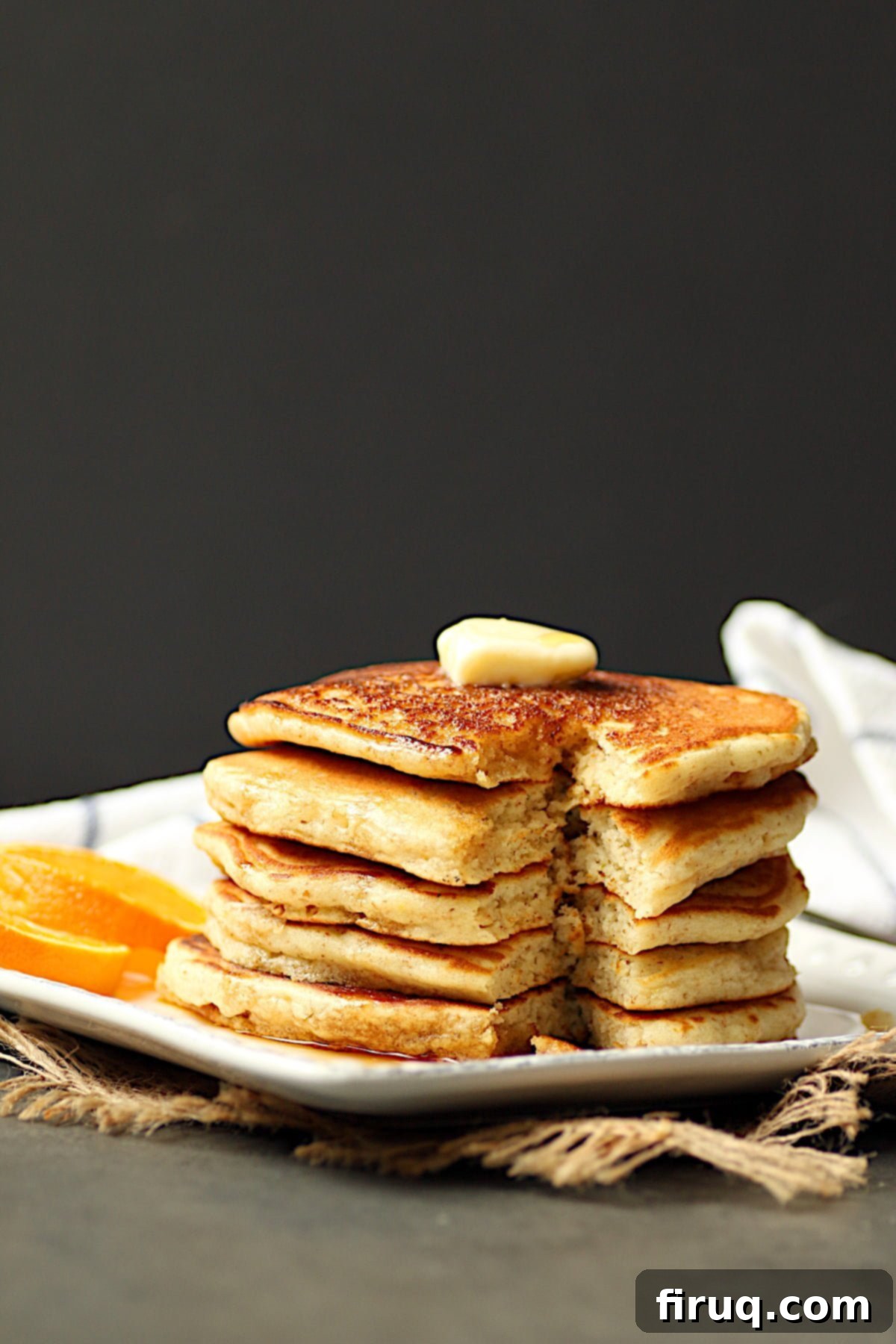
Austrian Shredded Pancake Nutrition Notes: A Healthier Twist
When comparing Kaiserschmarrn to standard American-style pancakes, you’ll find some notable nutritional differences, primarily due to the unique ingredient ratios. This Austrian classic, with its higher egg content (especially the inclusion of multiple egg whites), generally offers more protein per serving. Protein is essential for satiety and muscle maintenance, making Kaiserschmarrn a more filling and potentially more balanced option for breakfast or brunch.
Furthermore, because the recipe uses less flour relative to the eggs compared to many American pancake recipes, it often results in fewer carbohydrates per serving. This can be appealing for those monitoring their carbohydrate intake. The baking method also contributes to a different nutritional profile than fried pancakes, although the final sauté in butter does add healthy fats and rich flavor.
It’s important to remember that the nutrition information provided in the recipe below accounts only for the core Kaiserschmarrn dish itself. It does not include any additional condiments or toppings you might choose to enjoy, such as maple syrup, powdered sugar, fruit compote, or fresh fruit. These additions will, of course, increase the total calorie, sugar, and carbohydrate content of your meal. Always factor in your chosen accompaniments when considering the overall nutritional impact of your delicious Austrian Shredded Pancake.
Austrian Shredded Pancake (Kaiserschmarrn)
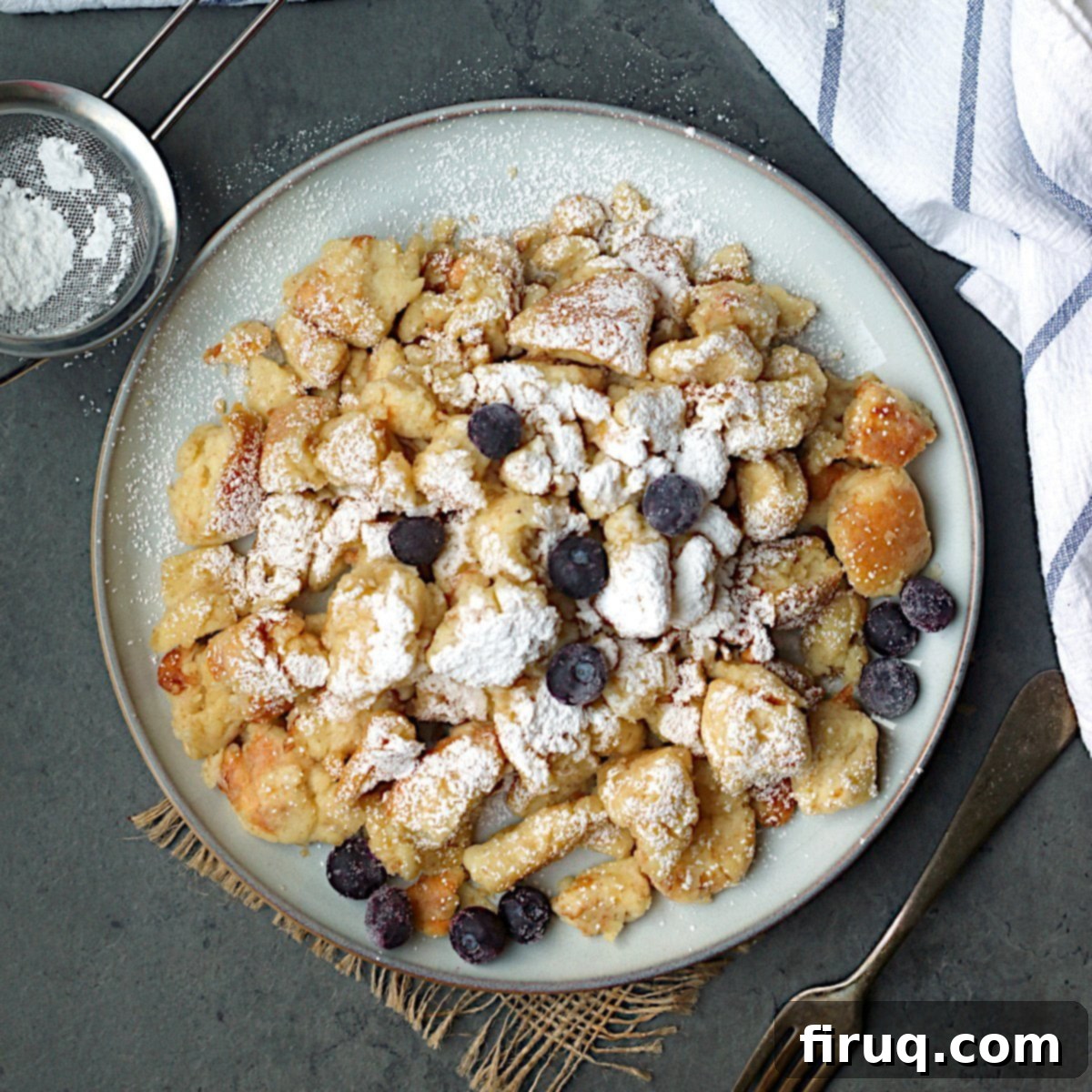
Print Recipe
Pin Recipe
Equipment
-
1 10″ cast iron or non-stick skillet
Ingredients
- 4 large eggs separated
- 3/4 cup milk (Use your favorite dairy-free milk to make this recipe dairy-free)
- 2 Tablespoons granulated sugar
- 3/4 cup all-purpose flour
- 1/4 cup whole wheat flour Optional – replace with 1/4 cup more all-purpose flour if desired
- 1/2 teaspoon baking powder
- 1/4 teaspoon salt
- 2 Tablespoons unsalted butter divided (substitute dairy-free butter alternative to make this recipe dairy-free)
- powdered sugar, syrup, and/or jam to serve Optional
Instructions
-
Preheat your oven to 400°F (200°C). Place a 10-inch oven-safe non-stick or cast iron skillet on the middle rack of the oven while it preheats. This ensures the pan is piping hot when the batter is added, promoting a beautiful crust.
-
Separate the egg yolks from the whites. Place the egg yolks into a large mixing bowl. Whisk in the milk and one tablespoon of the granulated sugar until well combined and smooth. Gently fold in the all-purpose flour, optional whole wheat flour (if using), baking powder, and salt until just combined. Be careful not to overmix the batter; a few small lumps are perfectly fine.
-
In a separate medium or large, clean bowl, using a hand mixer on medium speed, beat the egg whites with the remaining 1 tablespoon of sugar until they become foamy and form soft peaks. The egg whites should hold their shape but still be light and airy.
-
Carefully and gently fold the whipped egg whites into the egg yolk batter. Use a spatula to combine with a light, lifting motion. Continue folding just until no white streaks of egg white remain. Overmixing here will deflate the egg whites, resulting in a denser Kaiserschmarrn.
-
Carefully remove the hot skillet from the oven using oven mitts. Place 1 tablespoon of the butter into the hot skillet, swirling it around to ensure the entire bottom and sides are coated with melted butter. Immediately pour the prepared pancake batter into the skillet, spreading it gently and evenly. Transfer the skillet back to the preheated oven and bake for approximately 10 minutes. The pancake should be beautifully puffed and golden around the edges, but the center should still be slightly raw and somewhat jiggly (see image below for reference).

